
by Mark Smiley | May 26, 2021 | Main Articles
Homeless Camp Is Just Blocks From Park Hill Home Of Hickenlooper Who Said He Would End Homelessness; Advocates Demand The Homeless ‘Liberate’ Hick House For Use By All
by Glen Richardson
When the pandemic hit Denver last year and layoff climbed, the lack of affordable housing resulted in homeless encampments growing exponentially. As encampments multiplied, the problem began spreading to surrounding neighborhoods.
That’s where this story begins. More precisely in Denver’s Park Hill, a community that rivals Riverside Dr. in New York, the Auteuil and Passy in Paris, and Mayfair in London. The neighborhood was designed to showcase Mayor Speer’s Beautiful City Program. U.S. Senator and former Colorado Governor John Hickenlooper has a $2.5 million home here. With homes selling in five days or less, 52 homes and two condos were for sale last month, listed from $285,000 to $1,975,00.
This month an encampment with 45 shelters serving 50 people opens in a parking lot behind the church at 5209 Montview Blvd. The arrangement is scheduled to remain at least until Dec. 31. Homeless are being moved here from Capitol Hill. Suddenly, the plight of those living on the streets becomes intimately linked to the well-being of everybody else living in the neighborhood.
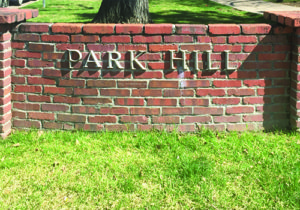
Hick’s Hood: Park Hill neighborhood was designed by landscape architect Fredrick Law Olmsted. Many of the neighborhoods first residences were designed by Fisher & Fisher.
Serenity Of Home
Hickenlooper, who as a U.S. Senator, spends much of his time in Washington, D.C. — the nation’s No. 1 homeless city — likely looks forward to returning to his Montview Blvd. home surrounded by an abundance of mature trees, lushly landscaped medians and generous setback. But with a homeless encampment moving within a block of Hick’s home he may soon be scanning Yelp reviews for a highly rated real estate agent.
The paradox is that Hickenlooper declared he would “end homelessness” with his Denver’s Road Home initiative in 2005. It was a miserable failure. An audit released in April 2019, by Denver Auditor Timothy M. O’Brien, CPA, concluded: “A lack of a cohesive overall strategy along with unclear authority and understaffing hindered the city’s ability to comprehensively address homelessness or measure the effectiveness of its efforts.”
The audit revealed that in 2018, the Metro Homeless Initiative identified 3,445 individuals experiencing homelessness. Around $37 million was budgeted for homeless services in 2018 and in 2019. Denver increased that to more than $51 million. In a warning seemingly still being ignored, O’Brien said, “Millions of dollars won’t help solve the problem if we aren’t tracking data and aligning our policies from organization to organization to support the use of the city’s resources.”
Camp Hick
Some homeless advocates are demanding that Hickenlooper make available his home to the denizens of the new Park Hill Safe homeless encampment. They point out the homeless will need places to go during the day and do not want to be stuck in a hot asphalt parking lot in the summer and what better than the green expanses of the Hickenlooper home. In the winter he could open up his home while he is off in Washington, D.C. “He promised to end homelessness in 10 years but failed miserably,” said David Johnson. “Opening up his home to the new Park Hill homeless residents is the least he could do to start making amends and if he won’t then the homeless should just go down there and take it over.”
Upset Neighbors Go To Court
Whether Hickenlooper is upset or not, other Park Hill residents are distraught and troubled. In the most significant attempt ever to block the establishment of the camping site, a group of Park Hill residents sued the nonprofit Colorado Village Collaborative, Park Hill United Methodist Church and the City of Denver to stop the neighborhood camping site. Residents in neighborhoods such as Globeville and Elyria-Swansea have vocally argued against camping sites, but this is the first lawsuit.
A temporary restraining order and preliminary injunction was filed by attorneys Heather Anderson Thomas and Douglas W. Baier on behalf of five plaintiffs on May 6. The site has not met the requirements set out by the city, according to the complaint filed by five Park Hill residents.
The lawsuit stated the proposed site “poses a real danger to minors and school-aged children, does not address the impact it will have on the neighborhood, and displaces people from an area with available resources to an area not equipped to handle the purposes of the camping site.”
Just 13 days after the injunction was filed, Denver District Court Judge A. Bruce Jones dismissed the lawsuit asserting that the plaintiffs had not exhausted all of their administrative remedies to the Denver Board of Adjustment for Zoning Appeals. The plaintiffs indicate they are now filing such an appeal but note that the camp will be in before the appeal is even heard.
Colorado Village Collaborative and Park Hill United Methodist Church celebrated the ruling with a joint statement declar
ing “we are grateful to the many Park Hill neighbors who have already opened their arms to receive their newest neighbors by expressing their support, opening their wallets, swapping recipes that will feed a crowd, and committing to volunteer on an ongoing basis.”
Not All Residents Hostile
Some residents in Park Hill believe that they must demonstrate their progressive values. They indicated that they would be willing to bake cookies and brownies for the new Park Hill homeless. Terrell wrote on Westword’s Facebook: “I am mortified today to say I am from Park Hill. That said, there are literally hundreds of us actively planning how we will welcome these brothers and sisters, and truly demonstrate what a privileged neighborhood can be capable of, beyond hate.”
Preschool Steps Away
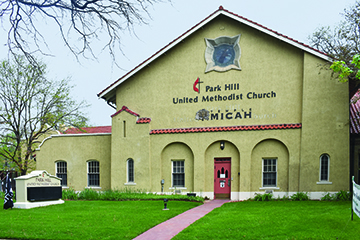 The homeless encampment will be just a few feet from the Children’s Center at Park Hill United Methodist Church. The pre-school offers half-day, full-day and after school programs. There are three public schools in the neighborhood, Park Hill Elementary School, The Goddard School of Denver and Odyssey School of Denver.
The homeless encampment will be just a few feet from the Children’s Center at Park Hill United Methodist Church. The pre-school offers half-day, full-day and after school programs. There are three public schools in the neighborhood, Park Hill Elementary School, The Goddard School of Denver and Odyssey School of Denver.
Residents in the Capitol Hill neighborhood where the encampment is being relocated from claimed that Morey Middle School near the site became a safety issue. “Tents lined the public-right-of-way between the street and the sidewalk outside of the school, and there were baskets and boxes filled with belongings.
Lara Lee Hullinghorst, a lobbyist and daughter of former Colorado Speaker of the House Dickey Lee Hullinghorst, said she was scared to walk out of her apartment without her husband or a friend after a man grabbed her arm and threatened to rape and kill her. She wasn’t certain, but believed the man lived in the camp across the street.
Church Champions Justice
Completing final preparations to share their space with unhoused homeless, Park Hill United Methodist Church — also home to Temple Micah — has a long hi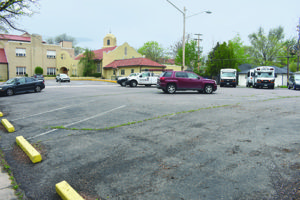 story of supporting racial and social justice. They’ve offered sanctuary to immigrants and refugees.
story of supporting racial and social justice. They’ve offered sanctuary to immigrants and refugees.
Moreover, they have been hosting women experiencing home
lessness for years through the Women’

Modern Skid Row: Denver’s homeless population is now at nearly the 10,000 mark, resulting in city adding more and more camping sites such as this, left. This type of encampment is coming this summer to Park Hill United Methodist Church, right.
s Homelessness Initiative.
Rules for the camp ask their new homeless residents to, “Be a good neighbor and treat private property, schools, children and families with respect.” Guidelines include no violence, weapons, drugs, or alcohol. Theft, fires, disruptive behavior, and trading and selling substances are forbidden. Whether any or all of these admonitions will be observed is unknown.
Today’s Hoovervilles
For most of us the magic thing about home is that it feels good to leave, and it feels even better to come back. Unfortunately, today in Denver many citizens can’t afford to come back.
Denver currently ranks 42nd in the nation when it comes to providing affordable housing for its low-income residents. As a result, every night, thousands of our fellow Denverites are forced to sleep on the streets without the warmth, safety, and security that so many of us take for granted.
As if harkening back to the Hoovervilles of the Great Depression, these settlements have become fixtures known as encampments.
Today Denver’s homeless population is 9,619, or 16.7 homeless people per 10,000 residents, according to a new study by website Porch.com. The website says the share of the homeless population in Colorado is now the 10th highest rate among the 50 states.

by Mark Smiley | Apr 23, 2021 | Main Articles
 With cute kids, kindly husbands and crowded kitchens, mothers are always fiercely protective of their kids and strive, despite obstacles, to help their families flourish. Albeit moms never dreamed a pandemic would trigger stay-at-home parents, the family matriarch has proven once again to be sensitive, demanding, practical, tough and supportive.
With cute kids, kindly husbands and crowded kitchens, mothers are always fiercely protective of their kids and strive, despite obstacles, to help their families flourish. Albeit moms never dreamed a pandemic would trigger stay-at-home parents, the family matriarch has proven once again to be sensitive, demanding, practical, tough and supportive.
As a result we desire to give extra recognition to moms this Mother’s Day, May 9. Something extraordinary to pay tribute to mothers — past, present, mothers-to-be, and those lost but forever remembered.
There’s a lot to offer this Mother’s Day with events and performances returning plus dine-in capacity has increased, albeit a fourth pandemic wave is a threat. Restaurants are offering the highest holiday dining choices since the pandemic hit. To prepare, use this guide to plan a weekend full of activities she’ll love.
Wining-Dining Mom

Seashore Spot: Blue Island Oyster Bar & Seafood in Cherry Creek North is offering a Mother’s Day brunch until 3 p.m., followed by dinner.
Blue Island Oyster Bar & Seafood, 2625 E. 2nd Ave. in Cherry Creek, is offering brunch until 3 p.m. plus dinner. Full menu includes Chilean Seabass, Swordfish “Paella,” and Filet Mignon. Information: 303-333-2462.
Carmine’s On Penn, 92 S. Pennsylvania St., is presenting a family style dinner for mom. Eatery’s dishes are prepared in two sizes: small for two, and the larger is family sized. Information: 303-777-6443.
Wash Park Grille, 1096 S. Gaylord St., is preparing a special Mother’s Day brunch menu, 10 a.m.-4 p.m. Seating for parties up to eight, larger groups can be accommodated at separate tables. Information: 303-777-0707.
Toro Latin Kitchen, 150 Clayton Ln., inside the JW Marriott Cherry Creek. Featuring brunch, patio stations include a Ceviche Raw Bar plus grill station serving lamb chops & mahi mahi tacos, 9 a.m.-2:30 p.m. Information: 303-253-3000.

Taste Of Toro: A patio brunch is planned by Toro Latin Kitchen in Cherry Creek featuring a grill station with lamb chops and mahi mahi tacos plus a Ceviche Raw Bar.
Blue Agave Grill, 1201 16th St. Mall, in the Tabor Center is offering brunch with “Mom Mimosas” flowing and flowers abound. Experience offered day and night, from the regular menu. Information: 720-550-8389.
Kona Grill, 3000 E. 1st Ave. inside the Cherry Creek Shopping Center. Earn “favorite child status” and enjoy “MOMosas.” Order from the regular menu. Information: 720-974.1300.
Fogo de Chao, 1515 Wynkoop, is offering brunch, 11 a.m.-2 p.m., dinner from 2-9 p.m. Dinner price is all day at the Brazilian steakhouse chain, children 7-12 half-price. Information: 303-623-9600.
Quality Italian, 241 Columbine St. inside the Halcyon Hotel. The Cherry Creek chophouse is offering food and drink menu specials but doesn’t elaborate. Information: 303-532-8888.
Distinctive Delights

Mother’s Day Tea: Make Mom’s special weekend complete by taking her to afternoon tea at the Brown Palace. Tea is served with plates of scones, finger sandwiches and sweets.
Chocolates & Bubbles — The Chocolate Lab, 2504 E. Colfax Ave., is featuring a Mother’s Day brunch tasting Saturday, May 8, 10:30 a.m. Begin by enjoying a sparkling cocktail with small bites, followed by a discussion of wines and chocolates. The tasting wraps up with additional scrumptious small bites. Information: 720-536-5037.
Mother’s Day Tea — Make mom’s special weekend complete by enjoying tea at the Brown Palace Hotel, 321 17th St. She’ll adore listening to the soft sounds of the grand piano float through the eight-story atrium. Tea topped with Devonshire cream from England comes with plates of scones, finger sandwiches and sweets. Information: 303-312-8900.
Music & Performances
Brantley Gilbert At Red Rocks — If mom is a country music fan, take her to Red Rocks to see the country crooner live, May 7-8. Information: 720-865-2494.
Disco Biscuits Play Mission Ballroom — The trailblazers of “trance-fusion” bridging the gap between electronic music and jam bands at the Mission Ballroom Mother’s Day weekend May 7-8, 8 p.m. Information: 720-577-6884.
Bluebird Theater Has RAC — The Portuguese-American musicians play electronica-dance music and live rock for mom May 8, 8 p.m. Information: 303-377-1666.
Art & Exhibits

Matriarch Magic: Restaurants are offering the highest amount of dining choices since the pandemic hit this Mother’s Day. Expect exquisite table settings such as this piece created by Toro Latin Kitchen in Cherry Creek North.
Colorado Women’s Art — Take mom to see the 30th Anniversary group exhibition by the 80-member Colorado Women’s Caucus for Art on display at D’art Gallery 900 Santa Fe Dr., May 6-30. Information: 720-486-7735.
Paris To Hollywood — Mom will love to see the fashion and influences of Veronique and Gregory Peck on display at the Denver Art Museum on Mother’s Day weekend and continuing through July 18. Information: 720-865-5000.
Apron Chronicles — If mom enjoys cooking she’ll adore seeing the photos, personal narratives and one-of-a-kind aprons on display at the History Colorado Center through May 31. Information: 303-447-9679.
Gardens Of The Mind — Take mom to view rarely seen Salvador Dali fanciful color lithographs of flowers and fruit at Denver Botanic Gardens on Mother’s Day weekend and continuing through Aug. 22. Information: 720-865-3500.
Translucent Reality — Artists in this exhibition on display through May 8 at Walker Fine Art, 300 W. 11th Ave., strive for enlightenment by shining through the veil where reality and fantasy overlay. Information: 303-355-8955.
Markets
Friday Night Bazaar — Grab mom for an evening of shopping, sipping and mingling in the RiNo Art District May 7. The bazaar features 40 local vendors, food trucks, craft beer and cocktails plus live music beginning at 5 p.m. Information: 720-398-6200.
Cherry Creek Farmers Market — Begin mom’s special weekend at annual Colorado Fresh Markets Cherry Creek marketplace at 1st Ave. & University May 8, 9 a.m.-2 p.m. Meet neighbors, friends and buy fresh produce while eating, drinking and enjoying café area. Information: 303-442-1847.
Sports
Colorado Rockies vs. Cincinnati Reds — The Colorado Rockies are partnering with Susan G. Komen Colorado for this May 10 Mother’s Day game, 1:30 p.m. Tickets include a $5 donation to cancer non-profit plus pre-game field access for a family parade around the warning track. Information: 877-465-6636.
Mother’s Day 5K — Cherry Creek Valley moms are on course to go the distance competing in Mother’s Day 5k events at City Park May 3 and 11 starting at 9 a.m. Information: runa.com.

by Regan Bervar | Apr 23, 2021 | Main Articles
“An old building is like a show. You smell the soul of an old building. And the building tells you how to redo it.” – Cameron Mackintosh
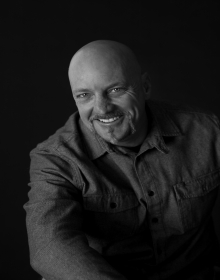 by Luke Schmaltz
by Luke Schmaltz
Casa Bonita stands shuttered alongside West Colfax like a circus gelding locked in a corral for which there is no key. First opened in 1974, the one-of-a-kind survivor from a bygone era is a testament to the optimism, pageantry and imagination of the previous century. But alas, it is currently silent as a result of COVID-19.

The Pink Palace is in the red. This 85-foot, 22-karat-gold domed tower can be seen for miles around.
As it was for most other Colorado restaurants, the mandatory order to close in March of 2020 was a crippling blow. Rather than partially reopen in May of 2020, Casa Bonita management chose to forgo the near-impossible strictures that social distancing would have placed on an entertainment concept built on human interaction.
Finally, more than a year later, there are rumblings of reopening — and a notice on the restaurant’s website confirms these murmurs. Yet, if there’s anything the last year has taught people, it is to not believe everything you read online. This is why a group of Denver residents and longtime natives who have lasting memories of this cherished institution are not going to take the possible death of fun sitting down.
Locals To The Rescue
Savecasabonita.org is a recently-launched initiative intent on spreading awareness of the cultural and historical importance of 52,000-square-foot restaurant, Casa Bonita. Led by Denver icon and Casa Bonita superfan Andrew Novick, this collective of innovators and entrepreneurs represents a larger segment of the Mile High populace that feels this beloved destination deserves another chance. “We have a large group of people in our consortium,” Novick begins. “The group we put together is made up of restaurateurs, folks who have built businesses from the ground up and branding experts. One of our people is a Latina businesswoman and we’ve talked a lot about the food and the cultural appropriation of Casa Bonita. The last thing we want to do is be a bunch of white men running a Mexican restaurant.”
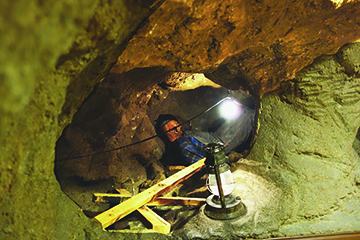
Proponents don’t want Casa Bonita to suffer the fate of The Miner in Black Bart’s Cave. Photo by Andrew Novick
An Unforgettable Experience
For those who have never been there, a visit to Casa Bonita is an immersion into experiential art, culture, kitsch and otherworldly wonder. It’s an escapade into a circus-like realm of cliff divers, puppeteers, gunfighters, family photos, cave adventures, arcade overindulgence and a hype man in a gorilla suit. And yes, there’s the Mexican fare, which can leave a bit to be desired at times, but the meals always finish strong with delectable honey-soaked sopapillas. “It’s always been about the experience, not the food.” Novick explains. “I mean, how many restaurants last for [almost] 50 years?”
Money Talks

Andrew Novick is Casa Bonita’s #1 fan. Photo by Jerilee Bennett.
Rather than attempt to influence the owners of Casa Bonita via community petition, Novick and his associates chose to start a GoFundMe campaign, as a monetary donation signifies a greater commitment than just a signature. With a goal of $100,000, the fund is quickly gaining steam and, at the time of this writing, sits at nearly half of the way in just three weeks. Novick is quick to point out that the money is not intended to pay any current debts the restaurant’s parent company may have outstanding. Rather, the funds would serve as a capital-bolstered basis for participating in the conversation about the future of the restaurant. Novick explains, “We are fundraising to have the power to have a voice in the conversation.” This could play out in any number of ways, from funding a PR campaign to advertise a grand re-opening to procuring legal counsel to broker a deal between the current owners and potential new investors.
A Wild Ride

Casa Bonita’s centerpiece, 30-foot-tall indoor waterfall is modeled after the cliffs of Acapulco and pumps 26,427,000 gallons of water per year, which supplies its 14-foot-deep pool into which cliff divers and actors plunge during the shows.
Understanding the history of the Casa Bonita ownership can be as overwhelming as a visitor’s first foray into Black Bart’s Cave. Initially, it was one component in a chain of themed restaurants that began in Oklahoma City, and branched out to Tulsa, Okla.; Little Rock, Ark.; Fort Worth, Texas; and Lakewood, Colo. The chain was the brainchild of artist, innovator and business mogul Bill Waugh, who was responsible for numerous spectacles of themed entertainment including the Crystal’s Pizza and Taco Bueno chains. In 1982, Waugh sold his company to Unigate, who, in 1992, sold it to CKE restaurants (owners of Carl’s Jr.) who then created a spin-off company in 1997 for the two remaining locations. Today, that company is known as Summit Family Restaurants which is a subsidiary of Star Buffet. When it comes to a discussion about the current state of affairs at the Pink Palace, however, no one at either entity is currently available for comment.
Stay Positive
Meanwhile, Novick and company are holding out for a positive outcome wherein the company culture is modernized, the menu is updated and the Casa Bonita fun machine gets jump started back into action. “We want to make sure that in the future, we (savecasabonita.org) are an important voice,” Novick says. “Whether someone else procures it or if they reopen, we want them to know we are the voice of the community and the fans. The funds we generate could be used to create awareness of the reopening and to revitalize the work environment for employees.” An electrical engineer by trade, Novick is also a realist. Concerning a scenario where the funds raised by savecasabonita.org do not afford them a seat at the negotiation table to have their voice heard by the owners or future buyers, he clarifies, “I want to point out that should the funds not be put to use, all donations will be immediately returned to the donors.”
Dream On

Casa Bonita is a Landmark of the Lakewood Historical Society.
As far as procurement of the intellectual property and the business model goes, just like any dedicated Casa Bonita regular, Novick and company are also dreamers. Ideally, Trey Parker and Matt Stone (creators of South Park) would swoop in, buy out Star Buffet, and entrust the locals to run the zoo. The duo made Casa Bonita a worldwide household name in a 2004 South Park episode which prominently featured the restaurant in all of its fantastically ridiculous glory. In this “everyone wins” scenario Novick, who celebrated his 300th visit to Casa Bonita in 2019 with a wildly successful charity event, could play an integral role. “I’ve done food events, experiential events and experiential art,” he explains. “I feel my role could be VP of experience.”
For now, however, the reality of the situation is that a huge piece of Denver history and yet another beacon of the soul of the city is at stake. Star Buffet filed for Chapter 11 bankruptcy on April 6, 2021. So, the harsh fact of the matter is that currently, it’s all about money.
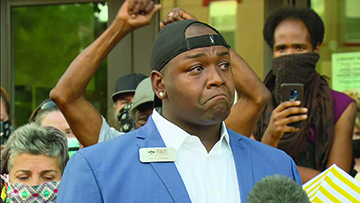
by Mark Smiley | Apr 23, 2021 | Main Articles
Criminal And Civil Failure To Report Gifts Added To Sexual Assault And Harassment Claims
by Glen Richardson

Worries Mount: Denver School Board Director Tay Anderson’s legal problems are growing. Two progressive organizations he has been a part of (Black Lives Matter 5280 and Never Again, Colorado) have accused him of either sexual assaulting or sexually harassing female members. Now the nonpartisan Campaign Integrity Watchdog has filed civil and criminal complaints concerning tens of thousands of gifts he has alleged to have solicited.
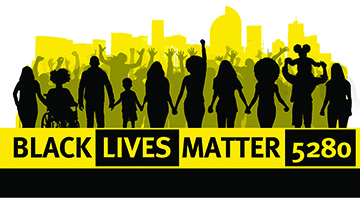 Tay Anderson, the highly controversial 22-year-old Denver School Board member’s legal problems are escalating at a dizzying pace. He is now facing new criminal misdemeanor allegations relating to his failure to file required reports on his repeated solicitation for gifts related to myriad events including claimed medical expenses, a trip to Washington, D.C., and a baby gift registry.
Tay Anderson, the highly controversial 22-year-old Denver School Board member’s legal problems are escalating at a dizzying pace. He is now facing new criminal misdemeanor allegations relating to his failure to file required reports on his repeated solicitation for gifts related to myriad events including claimed medical expenses, a trip to Washington, D.C., and a baby gift registry.
Sex Assault And Harassment
He was previously accused of sexually assaulting an unnamed woman by Black Lives Matter 5280 (“BLM”) which he denied and claimed he needed more information. BLM demanded that Anderson issue a public apology and seek assistance from a licensed professional with relevant expertise before he was welcomed at the group’s meetings or events. The group later stated that more women had come forward.
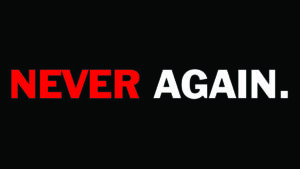 Anderson then acknowledged a May 2018 Denver Public Schools investigation found that he had engaged in retaliation while advocating on behalf of former Manual High School Principal Nick Dawkins, whom the district had investigated following employee complaints of harassment and bias.
Anderson then acknowledged a May 2018 Denver Public Schools investigation found that he had engaged in retaliation while advocating on behalf of former Manual High School Principal Nick Dawkins, whom the district had investigated following employee complaints of harassment and bias.
The six female members of a gun reform organization, Never Again Colorado, which Anderson served as president in 2018, issued a statement that Anderson created a hostile work environment making them feel unsafe by, inter alia, “talking in code about female board members in front of them (with romantic/sexual subtexts), daring female board members to perform sexualized actions, having conversations comparing the attractiveness of female board members, and making lewd comments in private to female board members.” The women were underage at the time of the incidents.
This time Anderson apologized and stated he would now “plan to engage and consult with restorative and transformative justice professionals.”
Anderson declared that he welcomed any investigation of his conduct. On April 6, 2021, he got his wish when the Denver Public Schools Board of Directors announced that it had secured an agreement with the Investigative Law Group to investigate the claims of women that he had assaulted and harassed them.
Anderson alienated many of his white female supporters in Central Park (formerly Stapleton) and elsewhere when he tweeted out “My brother really picked out a white woman with pumpkin pie over me for thanksgiving. This is another level of hurt.” The outrage over the implied racism caused him to delete the tweet.
Cornucopia Of Gifts For Anderson
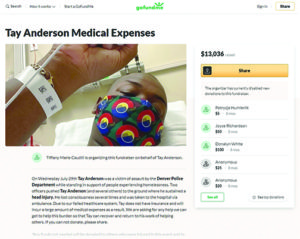 Campaign Integrity Watchdog, LLC, a non-partisan organization dedicated to campaign integrity and transparency of public officials filed an Economic Crime Complaint with the Denver District Attorney’s Office alleging criminal misdemeanors by Anderson for failure to report numerous fundraising solicitation schemes including:
Campaign Integrity Watchdog, LLC, a non-partisan organization dedicated to campaign integrity and transparency of public officials filed an Economic Crime Complaint with the Denver District Attorney’s Office alleging criminal misdemeanors by Anderson for failure to report numerous fundraising solicitation schemes including:
- Anderson claimed unspecified medical expenses alleging that on July 29, 2020, he “was a victim of assault by the Denver Police Department while standing in support of people experiencing homelessness” and hit his head. His campaign manager created a Go Fund Me page in which he received over $13,000 in gifts. He was required to report all gifts above $65 but failed to do so according to the Complaint.
- Anderson personally created a Go Fund Me page on September 19, 2020, to pay for his and others trip to Washington, D.C., for the funeral of Justice Ruth Bader Ginsberg and raised almost $13,000 and the Complaint indicates he again failed to report the same.

Gifts Galore: Campaign Integrity Watchdog has filed civil and criminal complaints against Tay Anderson for his failure to disclose tens of thousands of dollars of unreported gifts.
It also appears that Anderson began soliciting gifts in late 2020, of up to $1,000 on the Target website for a child he was expecting. There appear to be only 11 gifts he registered for that have not been purchased for him at press time. Anderson has had an interesting relationship with Target. He had tweeted that he and family members had been racially harassed at an unspecified Target location. Then on November 30, 2020, he tweeted that he had collapsed from severe chest pains while shopping with his family at Target. His failure to report the Target Baby Registry gifts would appear to potentially violate C.R.S. Sec. 24-6-203.
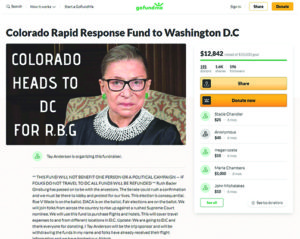 Anderson would not be subject to jail time under the statute but could be punished by a fine of up to $1,000 for each violation and the Complaint alleges multiple violations. Campaign Integrity Watchdog also filed a Complaint with the Colorado Secretary of State alleging campaign and political finance violations of C.R.S. Sec. 24-6-203, based on the same set of facts. The Secretary of State, Jena Griswold, could impose her own fines under Colorado law.
Anderson would not be subject to jail time under the statute but could be punished by a fine of up to $1,000 for each violation and the Complaint alleges multiple violations. Campaign Integrity Watchdog also filed a Complaint with the Colorado Secretary of State alleging campaign and political finance violations of C.R.S. Sec. 24-6-203, based on the same set of facts. The Secretary of State, Jena Griswold, could impose her own fines under Colorado law.
 Campaign Integrity Watchdog officer, Matt Arnold, stated that “public officials who deliberately evade the legal disclosure requirements for financial activity betray the public trust. Elected officials — and those seeking to obtain or retain elected office — cannot be above the law. Such ‘official’ violators must be held accountable to the law, so that ‘some animals — are not more equal than others’.”
Campaign Integrity Watchdog officer, Matt Arnold, stated that “public officials who deliberately evade the legal disclosure requirements for financial activity betray the public trust. Elected officials — and those seeking to obtain or retain elected office — cannot be above the law. Such ‘official’ violators must be held accountable to the law, so that ‘some animals — are not more equal than others’.”
Controversial Glendale Meeting
Tay Anderson became well known to Glendale residents when in July of last year, he appeared at a City Council meeting with State Representative Emily Sirota to protest Glendale agreeing with Governor Polis on masks while opting out of Tri-County Health Department’s requirements. He managed to alienate many at the meeting by verbally mocking and denigrating anyone who spoke with a position contrary to his own.
Anderson did not respond to requests for comment on the latest charges against him.

by Regan Bervar | Mar 19, 2021 | Main Articles
“This is the power of gathering: it inspires us, delightfully, to be more hopeful, more joyful, more thoughtful … more alive.” – Alice Waters
 by Luke Schmaltz
by Luke Schmaltz
It is with hopeful trepidation that most Denverites look to the summer months. Yet, while the vaccine rollout is having a diminishing effect on the pandemic, it may still be too soon to dig the picnic basket out of the attic. Regardless, Denver offers a dizzying array of festivals, fairs and outdoor events every year. Sadly, as most residents know all too well, most of them had to be skipped in 2020. With any luck, circumstances just might improve to where the simple joy of gathering with friends to enjoy the warm weather, great food and diverse entertainment the Mile High City’s legendary events have to offer.
“Pandemic fatigue” is one of the softer terms folks are using to call what most honest people are describing with more vivid language such as extreme shut-in fever, Covid-19 craziness, or isolation delirium. While reaching herd immunity through vaccination is a process that disrupts nature in a good way, social distancing is fairly unnatural for most, and could be blamed for the all-too ubiquitous modality of depression and malaise among the populace.
Taste Of Colorado

Taste: Taste of Colorado draws hordes of hungry visitors to downtown Denver every year.
Originally dubbed the Festival of Mountain and Plain, this gathering was established in 1895, and revived in 1983 by the Downtown Denver Partnership. Every year, restaurateurs, foodies, chefs, sauciers, pastry cooks and gustatory retail vendors of every stripe gather to market their businesses, showcase their talents and sell their treasures. The event happens every Labor Day weekend and is tentatively scheduled for September 4, 5 and 6, 2021. Britt Diehl, Senior Manager of Public Policy & Special Projects at DPP, explains, “… unfortunately we don’t have anything to report at this moment — we are looking at options based on public health guidelines/outlooks.”
CHUN People’s Fair
Every summer, the Capitol Hill United Neighborhoods Association (CHUN) throws a party in Denver’s Civic Center Park that offers something for anyone and everyone. This celebration of music, creativity and diversity welcomes artists, performers and spectators from every background imaginable in a two-day event that features music on over half a dozen stages. Typically held over the first weekend of June, the Fair was canceled in 2019 amid rumors of declining revenues and in 2020 for obvious reasons. Whether it is set for a resurgence in 2021 remains to be seen.
Cherry Creek Arts Festival

Arts Festival: The Cherry Creek Arts Festival hosts artists of every sort from around the world.
This event is perhaps the most approachable of all the offerings in an otherwise upscale, exclusive district. 2021 marks the 30th anniversary of this celebration of “Artivity” otherwise known as “Art for Everyone.” The event features “visual and performing arts and educational and immersive art experiences” and attracts upwards of 350,000 visitors along with 260 local and regional artists and hosts. The date for 2021 is yet to be set in stone, but if it takes place, it will most likely do so over the Fourth of July weekend — Friday, Saturday and Sunday, July 2, 3 and 4.
First Fridays
Denver art lovers have a total of six art walks to choose from on the first Friday of every month. These varied and diverse offerings take place across an array of vastly different districts and offer the city’s finest in galleries, museums and studios. These art walks take place in the River North Arts District, the Art District of Santa Fe, Golden Triangle Museum District, Tennyson Street Cultural District, South Pearl Street and 40 West Arts District and Block 7 Galleries. The latter is the most family-friendly of the lot, featuring a variety of dining options, a movie theater and a wintertime ice rink. Visitors to the previous five gatherings can expect to encounter a diverse offering of food trucks, restaurants, bars and breweries. Face masks are currently required by most establishments.
Cinco de Mayo


Cinco de Mayo: Cinco de Mayo is a beloved cultural tradition that will be celebrated regardless of an event being scheduled for downtown Denver.
This festival commemorating the victory of the outnumbered Mexican Army over French forces during the 1862 Franco-Mexican War takes place on or around the 5th of May. This year, that date falls on a Wednesday, so the tentative Civic Center Park celebration will take place on the weekend prior — depending on what event planners decide in what will most likely be an 11th-hour verdict. The two-day event attracts over 400,000 visitors and is particularly well known for offering an incredible array of Colorado Mexican cuisine and hosting events such as the Green Chili Bowl Cook-Off, a taco eating contest, a lowrider car show, and the infamous Chihuahua races.
The Colorado Dragon Boat Festival

Dragon Boat: The Colorado Dragon Boat Festival lights up Sloan’s Lake Park and has a definite date set for September 2021.
This unique gathering describes its mission as “the premier organization celebrating and promoting the culture, contributions and accomplishments of Colorado’s Asian-American and Pacific Islander (AAPI) communities.” Thankfully, this year’s event has a set date for September 25 and 26, in Denver’s Sloan’s Lake Park. Historically, the festival has taken place in July, but for 2021 event planners are no doubt hedging their bets on the theory that the pandemic curve will most likely flatten by fall rather than summer. Visitors can expect an otherworldly immersion in arts, entertainment, cuisine and of course — dragon boat races.
Large gatherings which are sanctioned and approved by the powers that be will return eventually, here’s to hoping it is sooner than later.

by Mark Smiley | Mar 19, 2021 | Main Articles
Wash Park Home Built In The 1890s Faces Wrecking Ball; ‘Park Won’t Be The Same If Home Is Razed,’ Residents Stress
by Glen Richardson

Stunning Site: Home, sweet historic home’s prominent location creates an established and familiar feature for both Wash Park and the Mile High City.
In a neighborhood where real estate is in high demand, demolition threatens a rare Wash Park Queen Anne home built no later than 1890. Neighbors were surprised and shocked when a demolition notice was posted at the 800 S. Franklin St. home by the City & County of Denver.
The oldest occupiable property from the 19th Century remaining in the neighborhood, it is located on a large corner lot across Franklin St. from Wash Park and across E. Ohio Ave. from St. John’s Church. The home is a rare remaining example of the Queen Anne Style in West Washington Park.
Representing the distinctive visible characteristics of a Queen Anne, it has the asymmetrical massing including projecting octagonal bays, steep gabled roofs, deep classical eaves and hooded windows. The porch features Tuscan order columns and classical entablature — an architectural section located above the columns on the building’s exterior. Largely developed 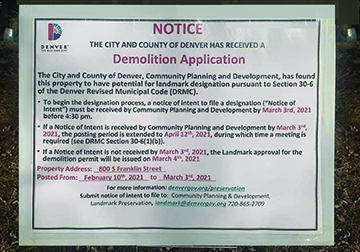 in the period between the world wars, many of the houses in the neighborhood were constructed in more revivalist or eclectic styles such as Tudor revival or Craftsman.
in the period between the world wars, many of the houses in the neighborhood were constructed in more revivalist or eclectic styles such as Tudor revival or Craftsman.
Saving Historic Site
Ironically the bid to bulldoze the $2,300,000 home was posted in March as Historic Denver began celebrating five-decades of saving and highlighting historic treasures under threat of annihilation. The non-profit got started by saving the Molly Brown House from demolition in 1970. The organization is hosting a 50th bash at the Molly Brown House Museum now through Sept. 19. The celebration includes a “50 Actions for 50 Places” campaign for sites worthy of preservation action.
Sixth generation Coloradan Drew Carder — who has spent nearly his entire life in Wash Park — is among the neighborhood admirers and supports nominating the Franklin St. home as a community mecca worthy of preservation protection. He says he doesn’t know much about the home other than it is one of the last remaining pieces of the neighborhood’s history. “I feel like this community should be given more of a chance to respond.”
Like Carder, Justin Moorland has spent most of his life in or around Wash Park. Today he lives on the 600 block of S. Gilpin, one block away from the Franklin St. house. “It has always been my favorite home at the park. I find it unique because of its obvious age, modesty and setting. It is truly from another era.” Admits Liz Schanker, “I guess that proximity gives me extra incentive to save the home.” She lives right next door to 800 S. Franklin and says she has lived in Wash Park long enough to be able to imagine the structure that would go up on the site and doesn’t want that to happen. “There is a plethora of new, urban mansions in the neighborhood but only one white farmhouse that predates the park.”
Stunning Setting

Stunning Site: Home, sweet historic home’s prominent location creates an established and familiar feature for both Wash Park and the Mile High City.
Set far back from Franklin St., the home has an unusually large front yard at the corner of E. Ohio. Because of the house’s large, open lot and prominent location, it creates an established and familiar feature for both Wash Park and the Mile High City. One of the neighborhood’s first buildings, it was constructed before the City of Denver became the City and County of Denver. Moreover, despite its age the house retains a high degree of integrity.
The original Queen Anne structure has experienced some alterations including the stuccoing of the masonry, the northern addition plus alterations to some window openings. Nonetheless, it still retains integrity of design, materials and workmanship to communicate its Queen Anne style. The home is in its original locations, and while the area around the house has been altered over time, the house retains its setting through its relationship to Washington Park and Smith Lake. The interior includes a breakfast nook, vaulted ceilings, walk-in closets and fireplace. The structure is encircled by a wrap-around front porch.
Bid To Bulldoze
Wash Park developer-builder Aaron Grant is the person seeking demolition of the historic home. He is owner-managing-broker of South Gaylord St.-based Grant Real Estate Co. Retailers and residents will recall it was his firm that bulldozed long-standing stores along Denver’s second oldest commercial block to build Park Coworking. The company website claims, “We maintain history and character in the Wash Park neighborhood through real estate design and development.”
In conversations with relatives of the owner who sold the house to Grant Real Estate, neighbors were purportedly told that Grant articulated to them “what they wanted to hear as a seller.”

Treasure Threatened: Demolition threatens this rare Queen Ann home located across Franklin St. from Wash Park. The oldest occupiable property from the 19th Century remaining in the neighborhood, the house has retained a high degree of integrity despite its age.
At the time he was purchasing the property, Grant also allegedly indicated that he wanted to keep the shell of the home and remodel the interior. “We know now this was probably never his intent,” they say.
Noteworthy Owners
According to the Denver Assessor’s records, 800 S. Franklin St. was constructed in 1890. If the date is accurate, it would make the house one of the earliest remaining buildings in the West Wash Park neighborhood. Additionally, it confirms the house was built prior to the City of Denver becoming the City and County of Denver, which was not until 1902.
The earliest record of home ownership was by lumber tycoon Joseph Sterling who started Sterling Lumber & Investment Co. Records suggest, however, the house may be older that 1890 as a 1900 fire destroyed building records prior to 1890. The last prominent person to live in the Franklin home was William H. Burnett, a distinguished jurist who served on the Denver County Court for 17 years.
In 1964 Burnett served as President of the Judicial Research Foundation and became head of the American Bar Association’s Section of Judicial Administration. The judge lived at the Franklin St. address with his wife Margaret from 1963 until his death in 1973. He was at the height of his career when he lived at the address, therefore the property bears a strong association with him and his significance as a local judge and reformer.


 The homeless encampment will be just a few feet from the Children’s Center at Park Hill United Methodist Church. The pre-school offers half-day, full-day and after school programs. There are three public schools in the neighborhood, Park Hill Elementary School, The Goddard School of Denver and Odyssey School of Denver.
The homeless encampment will be just a few feet from the Children’s Center at Park Hill United Methodist Church. The pre-school offers half-day, full-day and after school programs. There are three public schools in the neighborhood, Park Hill Elementary School, The Goddard School of Denver and Odyssey School of Denver. story of supporting racial and social justice. They’ve offered sanctuary to immigrants and refugees.
story of supporting racial and social justice. They’ve offered sanctuary to immigrants and refugees.



























